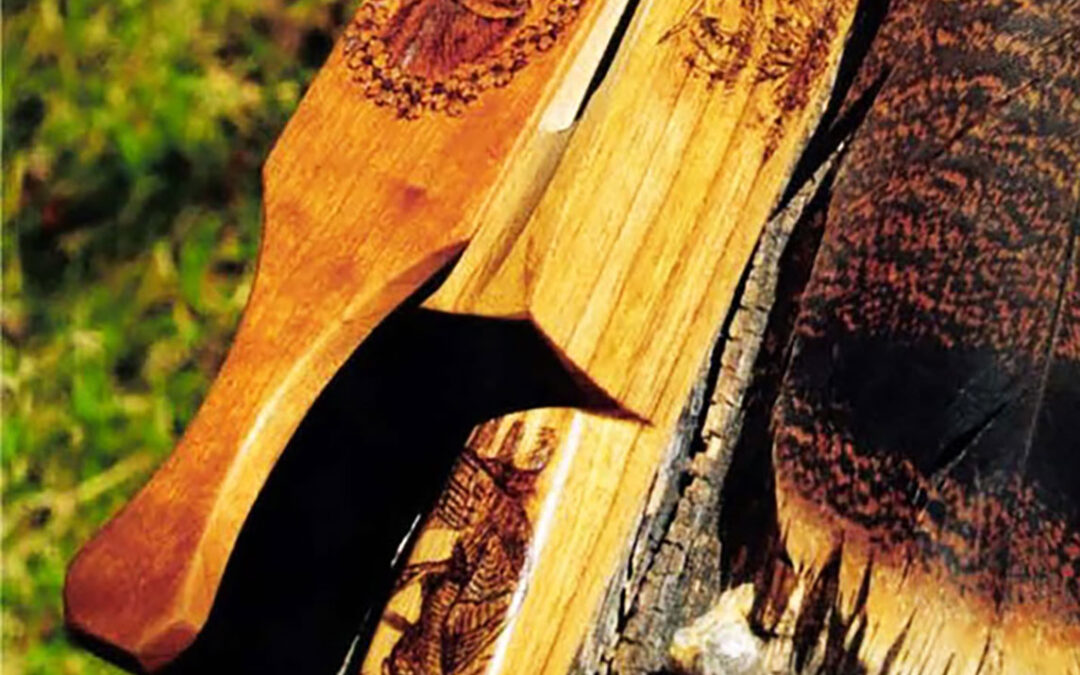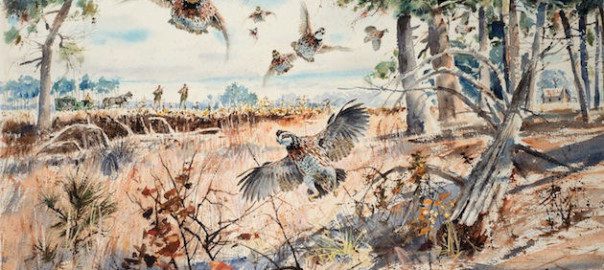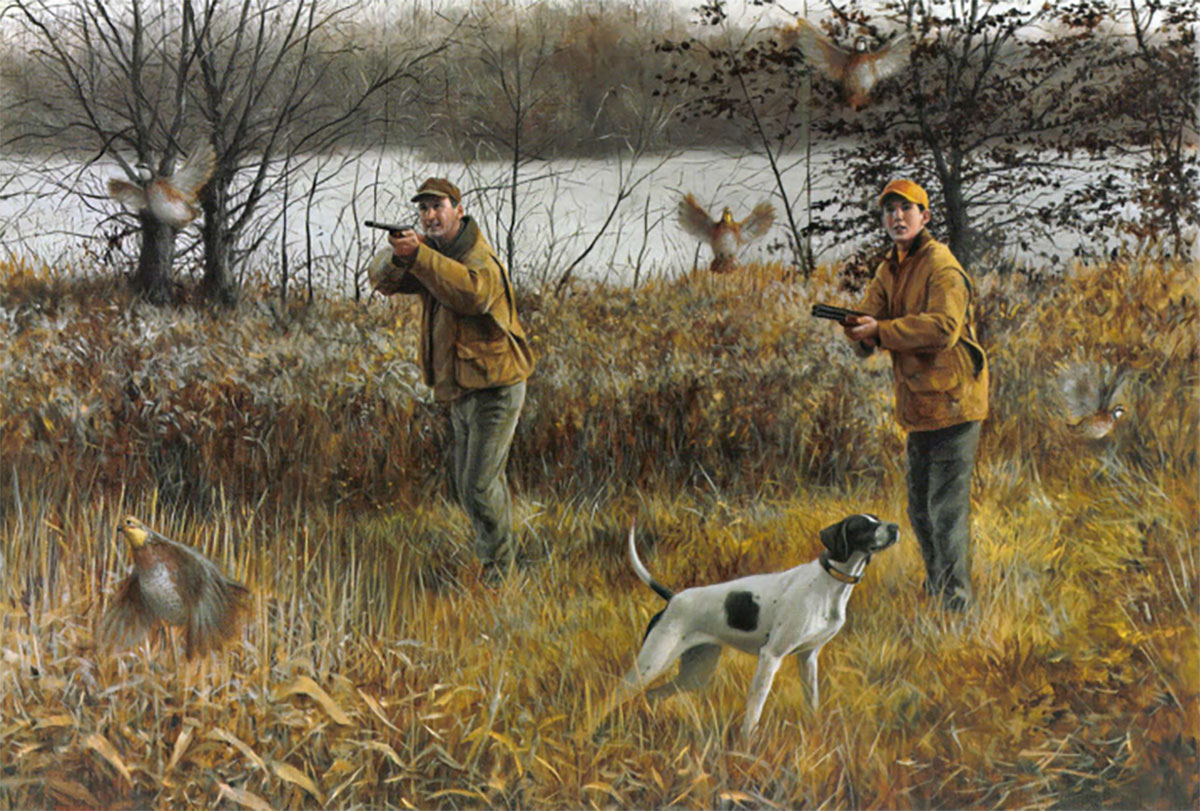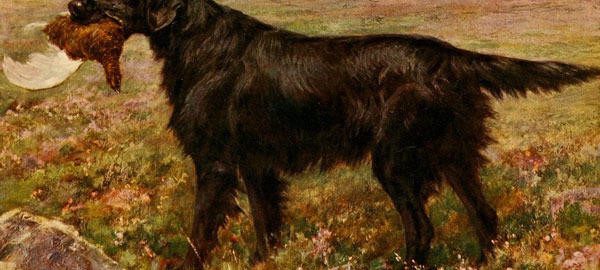Fine and decorative sporting art can gather up your soul, bringing happiness to you or whoever else might come to own and cherish it.
Life is life, and even in the theater of our greatest passion the difference between a laugh and a tear is as capricious as the impetuous drama of the morrow.
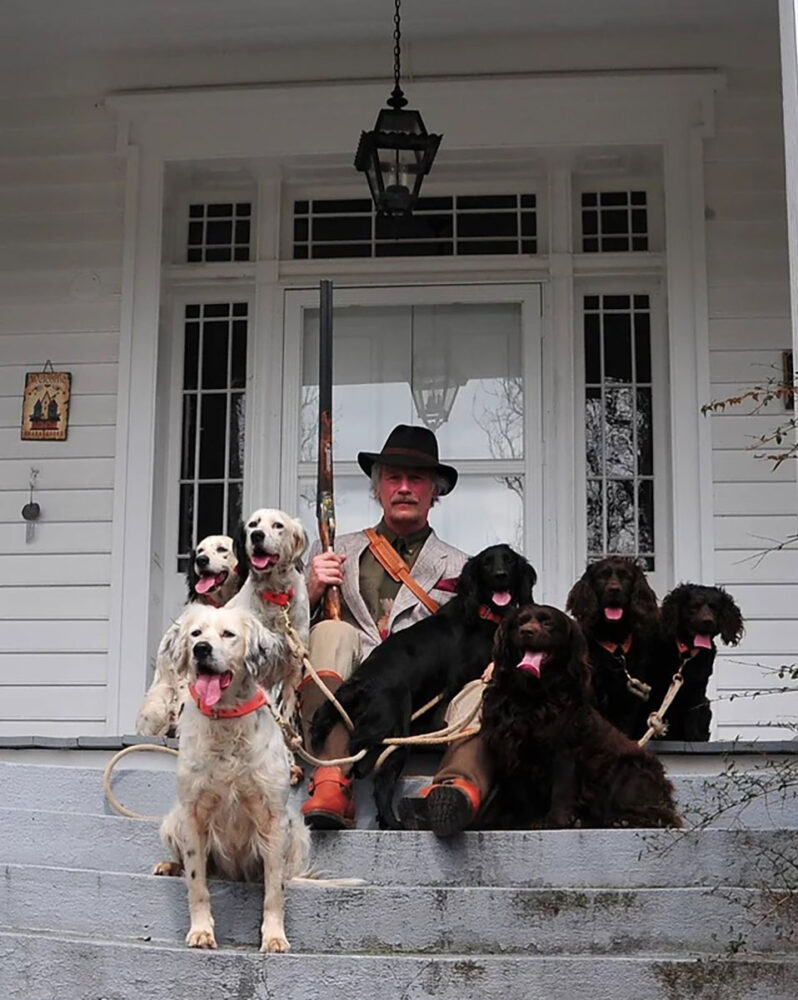
Mike Gaddis with his cherished companions.
In the sporting life, as in life everywhere, we encounter the same impulsive episodes of exalted happiness and depleting seizures of unfathomable sadness. Except that perhaps they are the more intense, I believe. For always there is the humbling grandeur of the physical and emotional landscape they are part of: the poignant beauty off wildness, woods, and water, quest and conquest, life and death and all the honest and undomesticated, water-colored sentiments they paint upon the tender canvas of yesterday’s memories.
One day is born and there is the enchanting “hunting time” call of the francolin in the fore of an East African sunrise; another dawns with the loss of a gun dog that has served with utter fidelity for the too-short gift of his lifetime, that has thrilled us with his courage and grace upon a hundred incomparable mornings.
One year brings again the solitude and serenity of an Appalachian hollow, steeped in the finery of autumn and the quiet smile behind the small dimple of hope that breaks gently upon a placid pool; only that the next bears the silent and somber passing of an era, a hurtful remembrance of the tellings and places that so endeared it, the soul-spent realization of how deeply it was a part of you, the piece of you that is forever gone.
One moment soars with the elation of triumph, that at last some wild and regal creature you have wanted so badly is your own; the next falls painfully to regret, that tomorrow he will no longer be there to return your challenge, that the tragedy of his absence lies uneasily upon your hands.
And with each moment, day and year, we are changed, to something better than we were before. The sum of all becomes the touchstone of our existence, and it is there we unerringly return in our times of greatest need. It is there we most often dwell. In the times we were happiest, the ones by which we were most affected. Or in times yet to be, which can be pleasantly imagined on the premise of grand times past. In this way we are able to advantage the balance. To perpetuate the joy of a treasured memory, to envision a dream.
Thus was born in antiquity the rich and completing design of our great sporting art heritage. Which will continue as long as any one of us is left to carry a gun afield, to unlimber a wand overwater. From the grandest painting to the most minute gesture of embellishment upon some small and valued item of the chase, the mood, matter and magic of the quest are rendered the more unquestionably dear. There is written the story of our being, in fond and poignant remembrance, in wistful muse. To sustain us in the times we are unable to return Out Home, as author John Madson so beautifully portrayed it, to enhance the emotion when we do. To have and hold, though in flesh and space it maybe gone, or to inscribe upon the morrow a yet unrequited dream.
In oils and acrylics on canvas, pencil on parchment, chisel upon steel, sculptures upon wood and stone, etchings on horn and bone . . . in creative and reconstructive conjurings upon a score of other mediums in a plethora of masterful motions, we have fashioned for ourselves monumental moments of contentment. Which we can cherish at our fingertips, so that even sadness is diminished bearably to peace.
So that how many times in the travel of our years will we pull down a fine gun, a fine rod of many seasons, place it across the bows of our rocking chair- — no hunt imminently ahead, no beat upon the morrow — and just comfort ourselves quietly with it for some hour, or more, in utter fulfillment? Midst emotions so compelling and bottomless we could hardly hope to explain them. Thinking of where it has been, where it still thinks to go, relishing at length each tiny flourish of adornment and artistry — in scroll and game, in script and gold — that so expertly recreates upon them a page from our years. They have become more than cane or wood or steel. They have become all that is us, and perhaps the more we yet yearn to be.
Commissioned in such manner, exultation abounds at every juncture of a life lived field and stream. I daresay we are gifted with sanctuaries a life spent otherwise is wont to perceive.
It’s why we can pull a thing so simple from our vest as a small silver cup, dip it into a wildwood spring — not only quench our thirst, but replenish our soul — as before we drink we warmly consider the image and inscription engraved upon its sides. For the ages. Not the least of the gratification, knowing it will outlast us.
Hardly less reverently than the adornments themselves, we cherish the artists who can so perfectly create them. The consummate masters of all the years, in whatever medium. The masters of the morrow, who thrillingly emerge along the way. Someone that can take the unpolished imaginings that are our heart-wish, and transpose them in unimagined flawlessness upon a talisman already we revere, and in the doing render it infinitely the more sacred.
Bringing this to earth seven decades into the journey, I rarely get more excited these days than when an unexpected, emerging talent floats to fore. Someone who can take the tumble of loose notes that have been floating around in the back of my head and compose them to music.
This time Jeff McKamey, my good friend and turkey call master from Ooltewah, Tennessee, was my benefactor.
“Gaddis, you’ve got to see this woman’s work. It’s not just good; it’s damn good!”
That knitted my knickers.
“I’ll send you some pic’chures.”
Fifteen minutes after I got them, I had him on the horn again.
“Create me a canvas, Jeff. I’ve got some things I been savin’. The three of us need to collaborate on somethin’ here.”
It took an of three minutes to decide on a longbox, flawlessly complexioned cherry on gently figured butternut.
“She’s in Gray Court , South Carolina,” Jeff announced, “and I’ll have this ready in the raw, git it to her the middle of nex’ week. Y’all can have at it. I’m itchin’ to see what happens.”
“Whooo-haw.”
A few days later I was delightfully working with a good-‘ol down-to-ground Pennsylvania-bred gal, long-since Southern, named Kelly Puckett. Who’s already a lot better than she knows. Just beginning to be truly tested, she is, and if she remains as dedicated as she is gifted, her name is going to quickly become venerated in sporting circles at large. Though she is a very capable air-brush and animal portrait artist, with some very notable scrimshaw work to her credit, her excelling gift at this juncture of an art career that started only four years ago is pyrography. That, if you can believe, she began just 11 months ago — her forte, turkey calls: boxes, trumpets, and pots — and already she has some of the most discriminating collectors in the country tapping at her door.
“I never really drew or painted a lot as a girl,” she reflects. “Too much of a tomboy, off in the woods or climbin’ trees.
“But there was my maternal Gran’ma Pearl,” she says, “and she could take a pair of scissors and a blank piece of paper and cut out anything you’d tell her — a cow, a horse, a man, a tree — I mean just perfectly. I reckon maybe that’s where some of it came from. And my family kept encouraging me to try.”
Then three years ago a call-maker asked Kelly to paint some turkey calls. She did, and very well. To the extent that a year after that she began independently posting some of her work on the predominant forums, the Ol’ Gobbler and Osage Roost, and it was “Katie, Bar the Door!” from there. Meteorically, she is becoming eagerly sought.
Last year, the first time out, Kelly — embellishing McKamey boxes — won third and fourth in the pyrography and painted call divisions of the NWTF National. It’ll only get better.
“I learned a lot,” she says. “Can’t wait ’til next year.”
Pyrography, or the art of decorating items by “drawing with fire” (wood-burning in vernacular), which in its crudest form is charred stick and pokerwork, is accredited most authentically to 700 AD Peru. Light-colored hardwoods, gourds, and vegetable-tanned leather have been the foremost mediums, and the artistic effects in the hands of a master, as evidenced by images from the World Gallery — the detail, soothing sepia-like tones and intricate shading — can be astounding.
In the world of tour-de-force sporting art, it is my perception that only rarely has wood-burning made the cut, most often tottering on the distinctly defined line between plebian and fine art. Well, Kelly Puckett is a gal, I believe, who will cross the river. Arguably, she already has. And I just wanted you to know her. Within the specific genre of high-end, wood-burned turkey instruments, Eric Rice, Sarah Clark, Jim Baltz and David Ferguson have been the front names, but I’ve a notion they have one-eye over their shoulder about now.
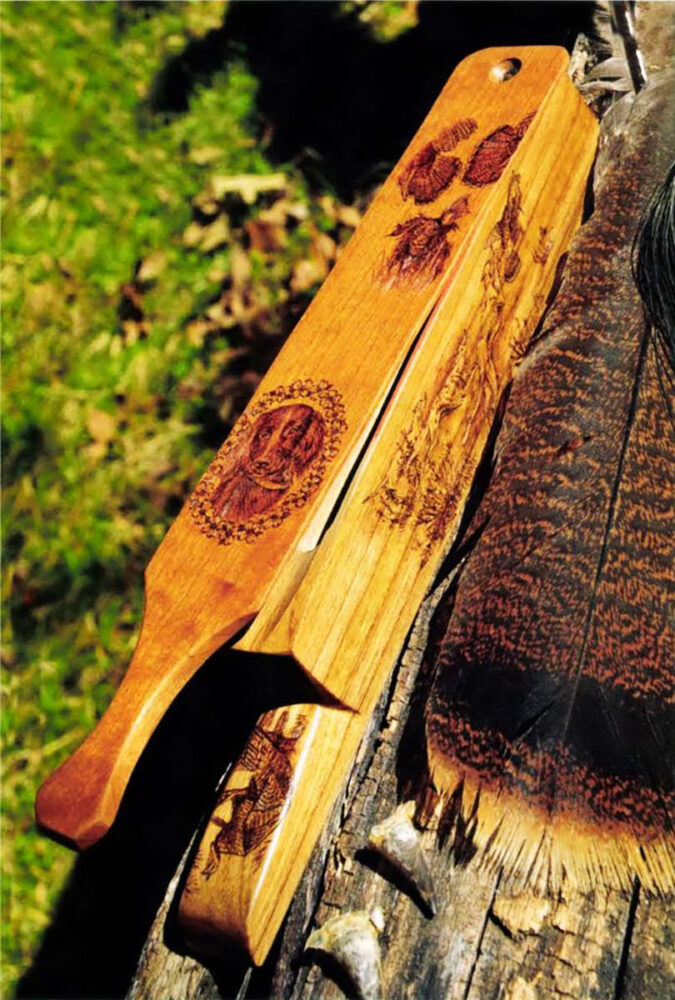
Working in pyrography, a specialized wood-burning technique, talented South Carolina artist Kelly Puckett created the images for this beautiful box call, built by Jeff McKamey, for the author.
The call Kelly did for me incorporates several favorite images I had saved for some time, waiting for the light opportunity: a cameo of my beloved English cocker, “Halle,” set in dogwood blossoms; a Hush scene courtesy of my Boykin male “Shad,” “My Little Man,” who died at 12 years even as the call was being adorned; a 1915 Ithaca catalog cover etching of fox and turkey I’ve always loved; a vintage scene of coursing dogs and turkey on the western prairie; an ol’ humped-up gobbler on a gobblin’ limb; an acorn from a timeless stalwart or Methuselah oak.
I wanted it clean, crisp, and uncluttered. You be the judge, but in my mind she did it about right.
I have it in hand now. It thrills and enthralls me, and will for my lifetime . . . and then someone more’s.
I believe that’s where we started here. Each time I hold it, sense it — in the chase or by the hearth — gathers up my soul, lifts me where I want to be.
That’s what fine and decorative Sporting art, at its personally appointed best, is meant to do.
It’s the timeless art of happiness. An individual measure of immortality, even if with the years it becomes anonymous.
Kinship is not always borne of blood. There will always be someone there to wonder, someone there to cherish it, someone there to care.
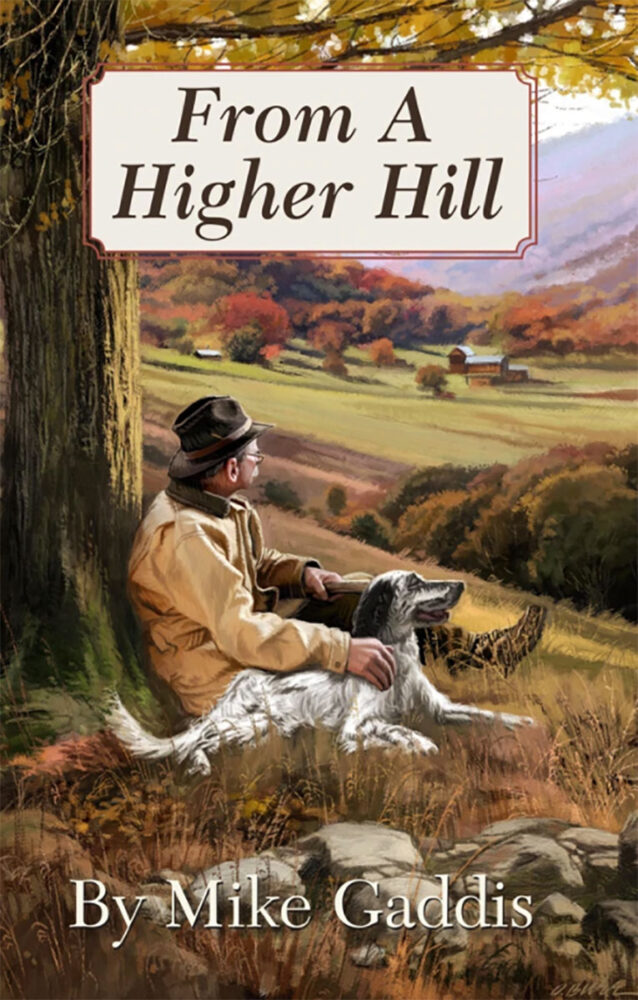 From A Higher Hill finds Mike Gaddis atop the enlightening vantage of almost eight decades. Looking back over the vast and enthralling sporting landscape of a life well lived. And ahead, to anticipate and savor whatever years are left to come.
From A Higher Hill finds Mike Gaddis atop the enlightening vantage of almost eight decades. Looking back over the vast and enthralling sporting landscape of a life well lived. And ahead, to anticipate and savor whatever years are left to come.
Upon this lofty precipice, one of the most celebrated and insightful sporting authors of our time again reaches beyond himself, this time retrieving sixty-five more episodic explorations of the sporting life, the whole of which transcend contemporary perspective, and ascend to rare and unexcelled poignancy. Buy Now

